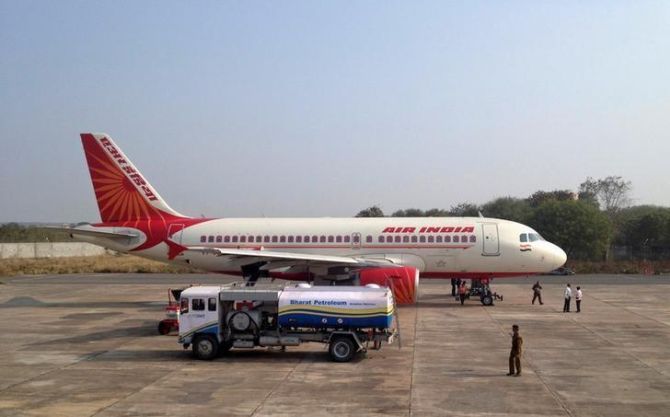One year since Tatas took over Air India, here’s how the journey has been
When the Tatas re-boarded Air India on January 27 last year, the price of aviation turbine fuel was at over Rs 80,000 per kilolitre.
Rupee was trading at around Rs 74 to a US dollar.
The Omicron variant of Covid-19 was in prevalence – barely a week earlier, India had reported over 340,000 cases on a single day.
Seven-day home quarantine of international travellers was the norm.
A year later, the Covid-19 pandemic fear has largely dissipated.
While jet fuel price and exchange rate has worsened compared to last January, travel demand has made a strong rebound.
(Domestic air traffic grew 47 per cent in 2022 on a year-on-year basis.)
With a generous dose of fund infusion and under a new management, Air India appears to be on a firm footing.
Air India’s domestic and international flights are growing month over month, indicating increased availability of aircraft and network expansion.
Data from aviation analytics firm Cirium shows Air India is operating nearly 15 per cent and 63.7 per cent more domestic and international flights, respectively, this month on a year-on-year basis.
Over the past months, Air India operationalised 20 aircraft that were grounded for want of spares and funds.
This required procurement of over 30,000 parts that had been cannibalised to keep other aircraft flying, the airline’s CEO Campbell Wilson had said in November.
On-time performance has improved, too.
Air India topped the domestic punctuality chart in October with over 90 per cent on-time flights.
In November it was placed second, while in August, September and December it came in third.
A rejig in flight schedules coupled with higher efficiency in turnaround of aircraft has helped in maintaining on-time departures.
AIASL, one of the two main ground handling agencies serving Air India, hired 6,500 staff in the past 16 months.
Maintenance of equipment such as step ladders, pushback tractors etc, too, has improved.
There are changes in on-board experience as well with revamped menus.
While these changes came earlier, recently, the airline’s alcohol policy was reviewed following an ugly incident where a male passenger urinated on a woman co-passenger in her 70s.
The incident invited both bad press and a Rs 30 lakh fine for the airline and a three-month ban on flying for the pilot.
Besides revising in-flight menus, the way food and beverages are served has also undergone a rethink.
Tea-coffee pots have been replaced with flasks.
New crockery has been introduced on its two leased Boeing 777 planes operating to San Francisco.
The crew has been instructed to increase in-cabin presence.
“Everyone is pulling their socks up,” a flight attendant pointed out.
Yet, despite some visible changes, there have been challenges.
A higher-than-expected number of experienced cabin crew opted for voluntary retirement when it was introduced last June.
This caused staffing problems and the management was forced to ask the crew to extend their release date.
Last month, this caused delays and cancellations too.
“The VRS could have been introduced after the new crew was trained and released for duty,” another crew member pointed out.
Air India has also been unable to fix complaints about broken armrests, worn out seat cushions or non- functioning in-flight entertainment system (IFE) on its Boeing 777 aircraft because of supply chain issues.
“Some parts are just not available and so, only patchwork is being carried out,” an official explained.
The existing aircraft seats and IFE are to be eventually replaced as part of a $400-million plan that the airline announced last month.
Air India did not respond to an email query from Business Standard.
A cultural change
“Buying planes is not new for Air India
“The biggest change to have taken place for the airline in this last one year is cultural,” an executive remarked.
In October, Air India moved out of its central Delhi office to a new interim location in Gurugram.
“This new place has an open-office culture.
“There are only a handful of cabins for the top management, while in earlier offices even managers used to have a cabin,” said this executive.
“The old ways of functioning, like making a note sheet (paper files) for proposals, have been done away with and processes are digitised.
“Air India is functioning like a performance-oriented organisation,” he added.
Helpdesks have been set up for key customers and a central customer care facility has been put in place for cargo.
The airline has become aggressive in sales and marketing.
But rival airlines aren’t losing sleep over all this yet.
“They are growing and we are growing, too,” an executive of a large international airline said.
“Our network is much wider and we continue to get business from corporate entities, including the Tatas,” he added.
On its part, Air India is scaling up its network with new frequencies to the US and UK.
Flights to Copenhagen, Milan and Vienna are being reintroduced.
According to John Grant, chief analyst at leading data platform, OAG, Air India’s long haul strategy is taking shape as it is building a stronger presence in the UK, which is one of its major markets.
This includes 17 additional flights to London.
“Air India has had a phenomenal run on long-haul routes as western carriers are banned from flying over Russia,” added Ameya Joshi, founder of aviation blog Network Thoughts.
“The airline operated 10 per cent fewer international flights last November compared to November 2019, but the number of passengers flown was less by only four per cent, indicating higher loads.”
Network consolidation
The Tatas have set in motion the consolidation of their four airlines into two.
In November-end, the Tatas and Singapore Airlines agreed to merge Vistara with Air India.
AIX Connect (earlier known as AirAsia India) will be merged with Air India Express.
Apart from a management overhaul, a rejig of the domestic network, too, is being carried out to drive synergies.
Thus, for instance, Bhubaneswar is to be served only by AIX Connect, and Air India will pull out of the destination.
“Network is being optimised keeping in mind passenger demand and limited capacity addition.
“So certain markets would be served only by AI and AIX Connect and some by both.
“AIX Connect has a stronger presence in Bhubaneswar and will serve the market,” a source explained.
Agreements such as interline and codeshares are being put in place between the group airlines that would provide better passenger feed and higher connecting traffic.
This is crucial as the current combined fleet size of the group’s four airlines is 218, while IndiGo has 300 planes.
“Campbell Wilson has pressed the accelerator after joining Air India in July.
“Fresh talent is being hired and plans are being drawn to reclaim the market share which Air India lost to overseas airlines,” said Jitender Bhargava, former executive director of Air India, adding, “Under the government ownership, there was no stress on employee productivity in Air India. Staff morale, too, was low and these issues are also being addressed.”
Source: Read Full Article



